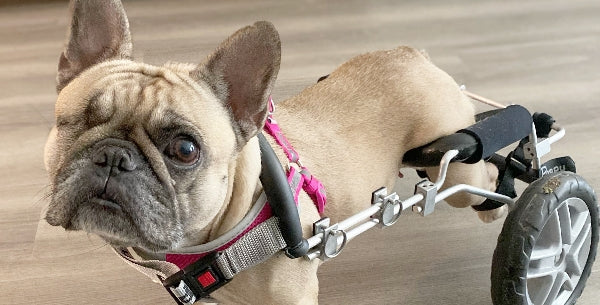In 24 cities

Caring for a Physically Disabled Dog
|
|
Time to read 5 min
Get product availability and delivery timelines based on your location.
Are you sure you want to delete this address?
Help us ensure a smooth delivery
Help us ensure a smooth delivery
SIZE GUIDE
|
|
Time to read 5 min
Caring for a physically disabled dog can be challenging, but it's also rewarding. With good knowledge and resources, you can ensure your dog leads a happy and fulfilling life. In this blog, we'll provide everything you need to know about caring for your disabled dog. So let's dive in!
The first step is to consult a veterinarian to determine the specific disability and its effects on your dog's health. Once you understand your dog's disability, consider adjusting your home environment to make it more accessible for your disabled dog. Creating a customized exercise and diet plan that accommodates your dog's physical limitations is also essential. It is crucial to be patient and supportive while caring for a physically disabled dog because they require extra attention and care. With care and support, disabled dogs can lead happy and fulfilling lives.
There are several types of disabilities that dogs can experience, including mobility issues, blindness, and deafness. For dogs with mobility issues, mobility aids such as wheelchairs or braces can help them get around more easily. Blind dogs can benefit from scent training and tactile cues to navigate their environment. Deaf dogs may need special training techniques and communication methods to understand commands. Knowing which type of disability your dog has will help you provide the appropriate care and support they need.
To care for a physically disabled dog, creating an accessible and safe living environment for them is of utmost importance. Installing ramps or lifts can allow your dog to move around the house, while non-slip flooring and removing tripping hazards can help prevent accidents. Providing easily accessible food dispensers and water bowls is also essential. Moreover, create a comfortable sleeping area with dog beds that are safe and easy for your disabled dog to rest on.
If you have a physically disabled dog, make your home as accessible and safe as possible. One of the first steps is to eliminate potential hazards in your home. Remove any objects that could be tripping hazards or cause injury to your dog, such as loose rugs or electrical cords.
Consider adding ramps or lifts so your dog can easily access areas they may have trouble getting to otherwise. These can be especially helpful for dogs with mobility issues or those who use a wheelchair.
Another step is to provide enough space for your dog to move around comfortably. Rearrange furniture or create wider pathways throughout your home. By making these adjustments, you can help ensure that your physically disabled dog can safely navigate their living space and maintain their quality of life.
Helping your physically disabled canine navigate the environment with mobility aids can significantly improve their quality of life. Wheelchairs and carts are excellent options for dogs with limited mobility, as they can help them move around independently. Dog Harnesses and slings are also effective in supporting dogs with weak limbs. All mobility aids must be correctly measured and fitted to ensure your dog's comfort and safety.
Feeding your physically disabled dog a balanced diet is crucial for their overall health and weight management. Consider consulting a vet to determine the best prescription diet for your dog by considering their specific needs and any health conditions. Generally, a high-protein and low-fat diet can help maintain muscle mass while controlling weight.
It's important to avoid feeding table scraps or human food, as they can cause digestive problems and upset your dog's stomach. Monitor your dog's weight regularly and adjust their diet to prevent obesity or malnutrition. Dogs with specific health conditions may need specialized diets, or dog supplements may be necessary. Providing your physically disabled dog with a well-balanced diet is vital for their care. Never overlook it.
Feeding smaller, more frequent meals can help manage weight and prevent digestive issues.
Specialized diets or supplements support joint and muscle health in dogs with mobility issues.
Proper grooming is crucial for maintaining your physically disabled dog's skin and coat. Use gentle, non-irritating shampoos and conditioners for dogs with sensitive skin to avoid allergic reactions or irritations. Keep their skin moisturized by using natural oils such as coconut or jojoba oil.
Regularly check your dog's skin for irritation, allergies, or infections requiring veterinary attention. Your veterinarian can recommend a good grooming routine and advise you on the best products.
Keeping your dog's skin and coat healthy is essential for caring for a physically disabled dog. Disabled dogs may have unique skin and coat care needs due to their mobility limitations or medication side effects.
Here are some best practices for keeping your disabled dog's skin and coat healthy:
Regular grooming: Brushing your dog's coat helps to remove dead hair and prevent matting, which can lead to skin irritation.
Moisturize: Dry skin can be a common issue for disabled dogs, so moisturize their skin with a gentle, pet-safe lotion or oil.
Avoid harsh chemicals: Some shampoos and tick and flea treatments can irritate your dog's skin or cause an allergic reaction. Ensure to use products specifically designed for dogs and free from harsh chemicals.
Follow these best practices to keep your physically disabled dog's skin and coat healthy and comfortable.
Taking care of a physically disabled dog can be challenging, but it is also rewarding. It requires a lot of patience, understanding, and love. Following these tips and strategies, you can help your disabled dog live a happy and healthy life. Remember to always consult with your veterinarian and seek specialist care when needed. Do share this blog with other pet owners who may find it helpful to take care of their furry friends!
Share this blog
Read More Articles
2 item in cart
₹10,360

